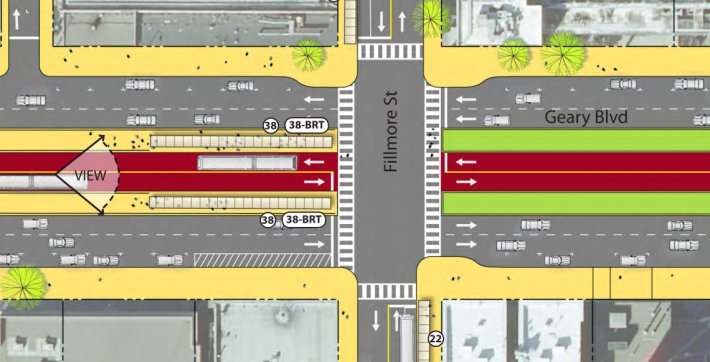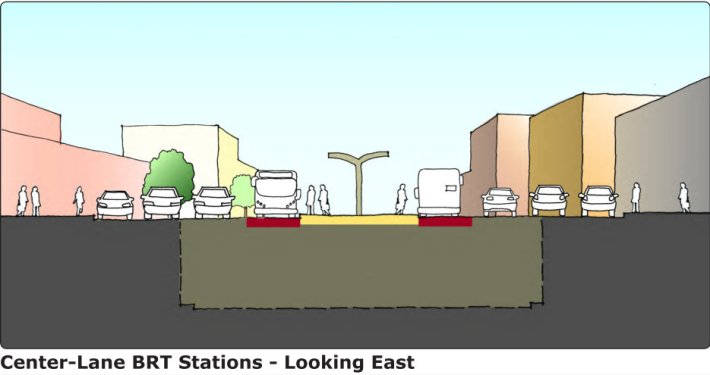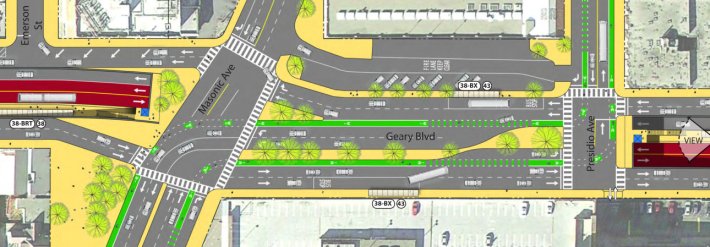Options for Geary BRT Come Into Focus
5:57 PM PDT on June 27, 2012

Just after San Francisco approved a preferred design for its first Bus Rapid Transit route on Van Ness Avenue, the SF County Transportation Authority showcased the latest conceptual proposals for a companion BRT project on Geary Boulevard.
Geary BRT, which has been fraught with delays over the years, is expected to bring relief to riders on Muni's notoriously sluggish 38-Geary line by significantly improving transit reliability and speeding up trips by as much as 30 percent.
The 38 follows Muni's first streetcar route, traversing nearly the entire length of San Francisco from the Transbay Terminal to Ocean Beach. With 50,000 daily riders, it is the city's busiest bus line. The BRT upgrade is expected to further boost ridership on the corridor, which carries as many travelers by bus as it does by car, according to SFCTA project leader Chester Fung.
"The buses don't arrive when we're expecting them to arrive, and they tend to bunch up when they get delayed by traffic," said Fung. "Bottom line, we want to improve bus travel time and bus reliability."
Geary BRT would speed up trips with features like dedicated bus lanes, off-board ticket machines, signal priority for transit, low-floor vehicles, and upgraded shelters. While all buses could potentially use the transit lanes, BRT buses would run as the 38-Limited and pass local buses in designated areas. Fung said planners are determining exactly which stops BRT will serve. The project will also include pedestrian safety improvements like sidewalk bulb-outs, and a number of left turns off of Geary may be banned.
These improvements have been a long time coming, with the project already delayed by four years. But SFCTA staff say they've learned some lessons from planning Van Ness BRT that should help them stay on track to meet their new target of completing the line in 2019.
What's caused so much delay? Opponents in the Richmond have fought the project, citing the loss of car parking, fears of construction hurting business, car traffic diverted to side streets, and the cost ($180 to $220 million, compared to the estimated $2.5 billion for surface-only light rail, or $5 billion to put it underground downtown [PDF]). SFCTA staff also say work on Van Ness BRT has taken time away from the Geary project.
Just like Van Ness, Geary has three major design options (plus a "no build" option, a.k.a. Alternative 1) that are being evaluated in the environmental impact report: Bus lanes running alongside the parking lanes (Alternative 2), center-running lanes in between a set of dual medians (Alternative 3), and center-running lanes alongside a single center median (Alternative 4). Each of those could be mixed-and-matched with options for special junctions, including filling in the Fillmore underpass and a Masonic intersection with a bike lane "jog" connecting parallel bike routes.
Advocates and planners are pushing for the center-running options, since separated center lanes are crucial to maximizing the speed and reliability of BRT routes. Members of the SF Transit Riders Union (SFTRU) said they support either of the two, as long as the bus lanes are fully separated from cars. Both could satisfy planners' goal of designing the project to be "rail-ready," meaning the street would be configured to easily accommodate rail, in case the city decides to install it in the future.
A hybrid design combining the two center-running options was chosen for Van Ness, but Geary might not need such a compromise. A major difference with Geary is that, unlike Van Ness, electric trolley buses don't run on it, said Fung, so the center median option is more feasible. That's because buses with left-side doors, which are needed to board at a center median, exist in motor coach form, but not in electric form. That issue killed the center median option on Van Ness.
Steep grades also pose some complications along Geary, said Fung. If BRT is ever converted to light rail, he said trains may not be able to traverse the hills without major engineering work. More pertinent to the BRT project, boarding stations can't be built on the Fillmore underpass largely because it lacks a flat surface, said Fung. The only solution to make a center BRT station at Fillmore feasible, then, is to fill in the underpass and re-connect Geary and Fillmore at the same grade.
The idea of a Fillmore fill-in, which would cost $40-$50 million, is strongly supported by residents since it would help reconnect the neighborhoods severed by the Geary expressway, planners said. In fact, SFCTA Deputy Director of Planning Tilly Chang said D5 Supervisor Christina Olague won't accept the Geary BRT project without a fill-in.
Car-focused community leaders in Japantown have even been pushing the absurd idea of filling the underpass with a new parking garage instead of dirt. (Aside from the untold price tag and the influx of car traffic it would attract, one planner pointed out that it wouldn't even yield many parking spots when the room needed to access those spaces is taken into account.)
Without a Fillmore fill-in, buses would have to weave from center lanes to the local mixed-traffic side lanes, which they use now. That subjects buses to blockages from car traffic and delivery trucks.
The Masonic-Presidio tunnel is less complicated. Boarding stations are proposed for either end of the tunnel, and passengers would connect to the upper deck via stairs and elevators. Under Alternative 2, the non-center-running option, buses would continue using the local side lanes as they currently do. Under either of the center-running alternatives, eastbound car access in the tunnel would be closed, with drivers diverted onto the two upper lanes.
On the upper section of Geary, where it intersects Masonic and Presidio, planners are proposing a bike lane "jog" (a series of turns) to connect bike routes on parallel streets. Although the SF Bicycle Coalition had previously pushed for bike lanes on Geary, it was met with resistance from the SFCTA due to the loss of parking or traffic lanes they would replace, and SFBC Deputy Director Kit Hodge said the organization is now on board with a new compromise.
"After looking at every possible way to add a high quality bikeway on Geary itself, we've transitioned to working with the SFCTA and SFMTA to designate a parallel bikeway on Anza Street (west of Masonic) and Post Street (east of Presidio Avenue) as part of the project," said Hodge. "Anza is a perfect twin to Cabrillo in dimension, and those bike lanes would immediately contribute to traffic calming work already underway in the Richmond District. Post Street already has bike lanes striped from Presidio to Steiner that could be extended."
While it may not meet the 8-to-80 standard, the bike lane jog would connect the proposed east-west route along Anza to Post (Anza turns into one-way O'Farrell when it hits Masonic) by guiding riders onto Masonic for one block, upper Geary for one block, and Presidio for another block to link to Post. North-south bicyclists using the raised bike lanes planned for Masonic from Geary to Fell Street could also use the jog to continue along Presidio.
On the downtown section east of Gough Street, where the 38 splits onto separate one-way streets, the existing bus lanes may be made more visible to keep drivers from blocking them, traffic lanes could be removed for sidewalk widenings, and bus shelters upgraded. SFTRU members said they'd like to see "a more robust" improvement plan for separating the bus lanes from car traffic than what they've heard.

On the other outer Richmond end, Fung said bus lanes may end at either 25th or 33rd Avenue, since traffic and ridership levels tend to drop so low. Ending them at 25th Avenue may reduce the project's cost and keep more parking spaces, which may help assuage complaints about parking loss.
It's unclear if opposition to the project from Richmond merchants has been quelled at all, but there weren't noticeable signs of it at Monday's community meeting at the Richmond Rec Center. SFCTA staff said they're looking at mitigating parking loss by creating new spots on side streets.
Mario Tanev and Brett Thomas of the SFTRU pointed out that merchants might be sold on the project's benefits to businesses using some demographic data. As Streetsblog has reported, San Francisco merchants who resist losing car parking often overestimate how many of their customers drive and underestimate how much non-drivers spend at their stores. And when Tanev and Thomas compared SFMTA ridership surveys [PDF] with U.S. census data, they found that income levels among Muni riders are mostly representative of SF's general population. That kind of empirical evidence, they said, could help make the case to Geary merchants that BRT is good for business.
The SFCTA plans to release its draft environmental impact report some time in 2013 and finalize it in 2014. According to the current schedule, construction would start in 2017, and Geary BRT would open in 2019.
Stay in touch
Sign up for our free newsletter
More from Streetsblog San Francisco
Streetsblog SF editor Roger Rudick offers constructive criticism of Chicago’s downtown bike network
"There were blocks that felt very safe and very secure," he said. "But then you're immediately – voom! – disgorged into three lanes of moving traffic with no protection."
Commentary: There is Zero Ambiguity to the West Portal Tragedy
What happened in West Portal was entirely predictable and preventable. The city must now close Ulloa to through traffic and make sure it can never happen again








